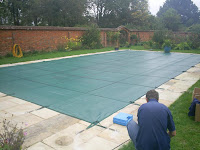New for 2013 the V5 Manual safety cover will be exclusively available to Cresta. The V5M Poollock safety cover offers all the manufacturing quality and precision engineering that you would expect from Poollock, but by being a manual cover it can be supplied and installed at more affordable price.
The geared crank winding mechanism allows the cover to be easily retracted off the pool, with the running gear traveling through a track system positioned behind the copings. The track can be recessed into the paving or fixed directly on top, with just a variation in installation cost.
By releasing the mechanism the cover can be then pulled back onto the pool by a leading edge and guy rope; as many manual solar covers are operated.
The cover is supplied with a dewatering submersible pump, this sits on top of the cover and pumps away any rain water that collects.
As sheet covers entirely encapsulate the pool you achieve a summer and winter cover in one, with the added reassurance of 100% safety. The cover material comes in a number of attractive colours and the UV protected PVc coating.
Benefits
Safety – You and even the extended family can walk on it; so unattended children being left in the garden or around the pool are safe from drowning. Curious pets and wildlife are also safe.
Debris Free – Be running through a track the cover encapsulates the pool preventing debris being blown into the pool throughout the year. Less maintenance in the summer and a far easier and cleaner pool come the opening in the spring.
Chemical Saving – By blocking out the UV the cover reduces the chlorine breakdown in water by sunlight. You therefore reduce your chlorine consumption have less of a chance of a green pool at any time of the year.
Heat Conservation – The sheet cover dramatically reduces the wind chilling and evaporation effect that cools the water normally. The covers also reduce rain dilution of heat and chemicals, especially during the winter months.
Appearance – We can’t avoid the roller at the end of the pool, but we do think the cover is more attractive than a bubble cover. Due to the track mechanism there is also no need to install a winter cover and therefore the steel anchor pins and drilled holes in the paving can be avoided.
For further details visit http://www.poollock.com/pl089/v5-manual.php?G1=5&G2=5&G3=0 or contact Simon at Cresta Leisure simon@cresta-leisure.co.uk for more details or a quote.


